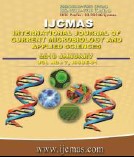


 National Academy of Agricultural Sciences (NAAS)
National Academy of Agricultural Sciences (NAAS)

|
PRINT ISSN : 2319-7692
Online ISSN : 2319-7706 Issues : 12 per year Publisher : Excellent Publishers Email : editorijcmas@gmail.com / submit@ijcmas.com Editor-in-chief: Dr.M.Prakash Index Copernicus ICV 2018: 95.39 NAAS RATING 2020: 5.38 |
Pigeon pea (Cajanus cajan L.) is grown in rainfed as well as dry region of India, growing of only pulses is not so much remunerative in present scenario of dry areas of agriculture to fulfill the diverse demand of consumers and rapid growing population. A field experiments was conducted during the Kharif seasons of 2005 and 2006 at Birsa Agricultural University Farm, Ranchi, Jharkhand to assess the energetics and production potential of pigeon pea (Cajanus cajan L.) in sole and intercropping with different duration (short, medium, and long) cultivars of finger millet under 1:1, 1:2, 1:3 and 1:4 row proportions. Sole crops of pigeon pea and finger millet always showed highest yield attributes that decreased due to intercropping with different duration cultivars of finger millet and number of rows of finger millet. Pods plant-1, seeds pod-1 and 100 seed weight of pigeon pea and ears m-1 row length, seeds ear-1 and test weight of finger millet were recorded higher under pigeon pea and finger millet intercropping system in 1:1 row ratio and reduced in 1:4 row ratio. The maximum grain yield 10.9qha-1 was obtained with pigeon pea sole which was significantly superior to intercropping systems. Grain yield of pigeon pea increased with decreased in row ratio of finger millet and grain yield of finger millet increased when row ratio of finger millet increased. The maximum pigeon pea equivalent yield i.e. 13.13 qha-1, net returns (Rs. 15090.5 ha-1) and benefit: cost ratio (2:31) was recorded when pigeon pea intercropped with finger millet in 1: 1 row combination with short duration cultivars of finger millet. When row ratio of finger millet increased energy use efficiency and net energy output of biomass increased and specific energy was decreased irrespective of all the cultivars.
 |
 |
 |
 |
 |